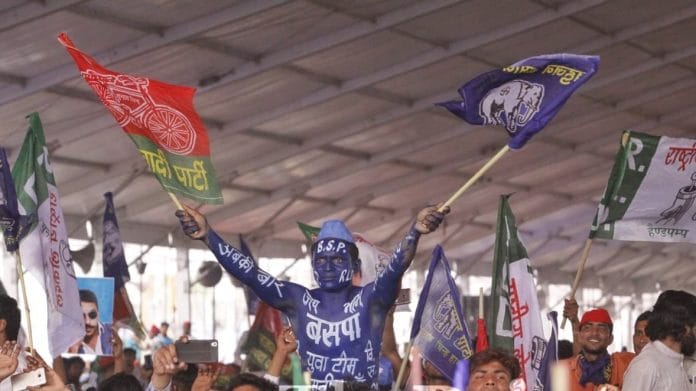As the ‘Congress system’ collapsed in Uttar Pradesh and one-party rule caved in before the forces of “Mandal and kamandal”, the state quickly became multi-polar.
UP elections, both Lok Sabha and Vidhan Sabha, have for 30 years been a multi-party contest. For much of these 30 years, there have been at least four significant players: The Samajwadi Party (SP), the Bahujan Samaj Party (BSP), the Bharatiya Janata Party (BJP) and the Congress.
The 2019 Lok Sabha election is a rare event when UP is having a truly bi-polar contest. Perhaps the only other time this happened was the post-Emergency election of 1977.
A new dynamic
Team Modi and Team Anti-Modi are the two sides this election. Everything else, Mandal and kamandal included, has gathered itself into one of these teams. The political conversation around the mofussil tea shops is not who’s cutting whose votes.
No, the Congress is not a player in this election. With the exception of an odd seat here or there, it is not even in contention. In most places, it is not even cutting any votes.
The coming together of the SP, the BSP, and the Rashtriya Lok Dal (RLD) had anyway made the Congress irrelevant. If there was any doubt about it, the party has itself made it clear that it is mostly playing vote spoiler to help the gathbandhan.
The seats where it is damaging the gathbandhan are mostly being contested by the BSP. On most such seats, the Congress is too weak to even be vote spoiler. For instance, ThePrint travelled to Sitapur near Lucknow where the Congress’ Kaisar Jahan is popular with Muslims but voters from the community were nevertheless clear: This is a gathbandhan election.
The 2014 Lok Sabha and 2017 assembly election results in UP can offer us only a limited insight into the 2019 polls, because the unique bi-polarity of this contest is producing a unique dynamic whose form will only be clear with the result. That is why few are able to give a definite assessment about how many seats which side is winning this election.
Also read: BJP has NISHAD party support in Yogi’s Gorakhpur, but the Nishads may not vote for it
The direction of the wind
Indian voters notoriously decide their vote according to the “hawa”, the direction of the wind. Like pollsters and journalists, voters also seek to gauge the sentiment of other voters.
As this reporter travelled through UP, many voters said other voters were silent. “Is baar koi khul ke nahi bol raha hain (This time nobody is talking openly),” goes a common refrain. Asked why this was the case, they didn’t know. Perhaps this is less a reflection of any ‘undercurrent’ and more of a widespread lack of enthusiasm.
Nevertheless, this reporter asked many voters, party workers and local journalists in different parts of central and east UP what they thought the direction of the wind was.
The broad public sentiment is that both sides are evenly matched. Despite PM Narendra Modi’s popularity, the gathbandhan’s caste arithmetic is fighting back. “Takkar toh hai,” people on both sides of the Modi divide say. There *is* a contest, and after the BJP sweep of 2014 and 2017, that’s quite a change.
If BJP supporters say “takkar toh hai” even in Gorakhpur, a bastion of the party for decades, you can be sure this is not a one-sided election. In some places, you will even hear that this election is a “kaantein ki takkar“, a cliffhanger.
“Kos kos pe badle pani, char kos pe vani”, it is said about the Hindi heartland. Every mile, the water tastes different, every four miles, the dialect changes.
Such diversity was over-ridden by a Modi wave in 2014 and 2017. The gathbandhan, by bringing together all anti-Modi forces, is seeking to reclaim the local from the national.
BSP and SP workers on the ground have worked on this election with the slogan “Haathi, lathi aur saat sau chhiyasi”. “Haathi” is a reference to the BSP’s symbol, the elephant, and used here to refer to its core voters, Jatav Dalits. “Lathi” is the Yadav’s stick to shepherd cattle. And “786” a reference to Muslims.
The gathbandhan’s focus, thus, has only been on uniting these three communities and ensuring vote transfer to each other’s parties. This election, they have not even tried to win non-Yadav OBC votes, except for giving them many tickets, leave alone upper castes.
The caste polarisation is thus a neat line through the middle. The gathbandhan has used its demographic consolidation to make it a seat-by-seat election.
When you drive into constituencies like Chandauli, Bhadohi or Ghazipur near Varanasi, it is clear that the BJP is falling weak before the gathbandhan’s arithmetic. The BJP supporter’s tone will give it away.
The sound of the local dialect is different once again, the water no longer tastes the same from one constituency to the other.
Fifty-fifty
Sitting in Gorakhpur BJP candidate Ravi Kishan’s office, a BJP worker gives his personal estimate: 40-50 of UP’s 80 seats for the BJP. Ask gathbandhan workers and supporters, and they also estimate 40-50 seats for the alliance.
The broad picture of what this election in UP feels like was best summed up by a Brahmin government employee in Bhadohi who refused to reveal his own voting preference. “Fifty-fifty hai,” he said.
It might not turn out that way, who knows? But to the extent that voters’ perception of the election shapes the final result, it’s fifty-fifty in UP.
Also read: Narendra Modi’s name doesn’t mean hope for voters this election, but his schemes do







Fifty fifty is too generous to the incumbent. It should be pleased to touch thirty.